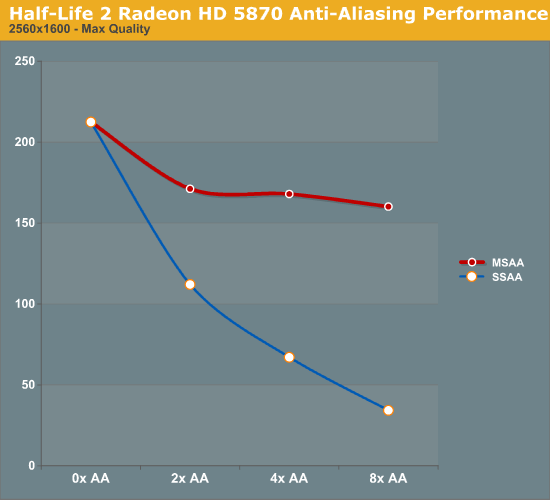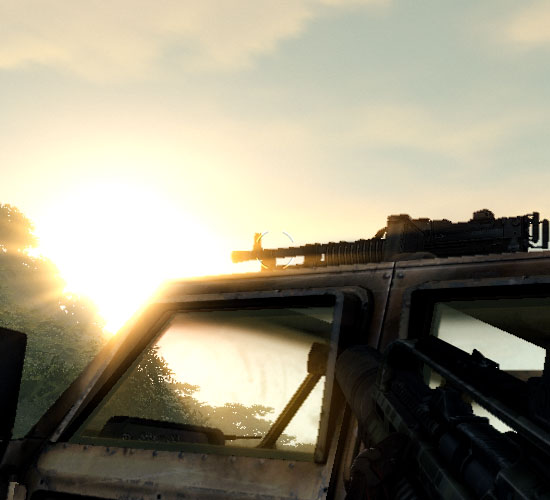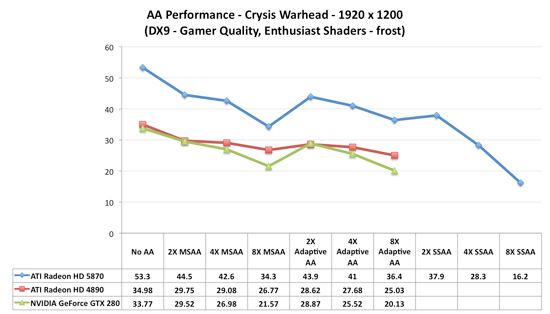AMD's Radeon HD 5870: Bringing About the Next Generation Of GPUs
by Ryan Smith on September 23, 2009 9:00 AM EST- Posted in
- GPUs
AA Image Quality & Performance
With HL2 unsuitable for use in assessing image quality, we will be using Crysis: Warhead for the task. Warhead has a great deal of foliage in parts of the game which creates an immense amount of aliasing, and along with the geometry of local objects forms a good test for anti-aliasing quality. Look in particular at the leaves both to the left and through the windshield, along with aliasing along the frame, windows, and mirror of the vehicle. We’d also like to note that since AMD’s SSAA modes do not work in DX10, this is done in DX9 mode instead.
|
AMD Radeon HD 5870
|
AMD Radeon HD 4870
|
NVIDIA GTX 280
|
| No AA | ||
| 2X MSAA | ||
| 4X MSAA | ||
| 8X MSAA | ||
| 2X MSAA +AAA | 2X MSAA +AAA | 2X MSAA + SSTr |
| 4X MSAA +AAA | 4X MSAA +AAA | 4X MSAA + SSTr |
| 8X MSAA +AAA | 8X MSAA +AAA | 8X MSAA + SSTr |
| 2X SSAA | ||
| 4X SSAA | ||
| 8X SSAA |
From an image quality perspective, very little has changed for AMD compared to the 4890. With MSAA and AAA modes enabled the quality is virtually identical. And while things are not identical when flipping between vendors (for whatever reason the sky brightness differs), the resulting image quality is still basically the same.
For AMD, the downside to this IQ test is that SSAA fails to break away from MSAA + AAA. We’ve previously established that SSAA is a superior (albeit brute force) method of anti-aliasing, but we have been unable to find any scene in any game that succinctly proves it. Shader aliasing should be the biggest difference, but in practice we can’t find any such aliasing in a DX9 game that would be obvious. Nor is Crysis Warhead benefitting from the extra texture sampling here.
From our testing, we’re left with the impression that for a MSAA + AAA (or MSAA + SSTr for NVIDIA) is just as good as SSAA for all practical purposes. Much as with the anisotropic filtering situation we know through technological proof that there is better method, but it just isn’t making a noticeable difference here. If nothing else this is good from a performance standpoint, as MSAA + AAA is not nearly as hard on performance as outright SSAA is. Perhaps SSAA is better suited for older games, particularly those locked at lower resolutions?
For our performance data, we have two cases. We will first look at HL2 on only the 5870, which we ran before realizing the quality problem with Source-engine games. We believe that the performance data is still correct in spite of the visual bug, and while we’re not going to use it as our only data, we will use it as an example of AA performance in an older title.

As a testament to the rendering power of the 5870, even at 2560x1600 and 8x SSAA, we still get a just-playable framerate on HL2. To put things in perspective, with 8x SSAA the game is being rendered at approximately 32MP, well over the size of even the largest possible single-card Eyefinity display.
Our second, larger performance test is Crysis: Warhead. Here we are testing the game on DX9 mode again at a resolution of 1920x1200. Since this is a look at the impact of AA on various architectures, we will limit this test to the 5870, the GTX 280, and the Radeon HD 4890. Our interest here is in performance relative to no anti-aliasing, and whether different architectures lose the same amount of performance or not.
Starting with the 5870, moving from 0x AA to 4x MSAA only incurs a 20% drop in performance, while 8x MSAA increases that drop to 35%, or 80% of the 4x MSAA performance. Interestingly, in spite of the heavy foliage in the scene, Adaptive AA has virtually no performance hit over regular MSAA, coming in at virtually the same results. SSAA is of course the big loser here, quickly dropping to unplayable levels. As we discussed earlier, the quality of SSAA is no better than MSAA + AAA here.
Moving on, we have the 4890. While the overall performance is lower, interestingly enough the drop in performance from MSAA is not quite as much, at only 17% for 4x MSAA and 25% for 8x MSAA. This makes the performance of 8x MSAA relative to 4x MSAA 92%. Once again the performance hit from enabling AAA is miniscule, at roughly 1 FPS.
Finally we have the GTX 280. The drop in performance here is in line with that of the 5870; 20% for 4x MSAA, 36% for 8x MSAA, with 8x MSAA offering 80% of the performance. Even enabling supersample transparency AA only knocks off 1 FPS, just like AAA under the 5870.
What this leaves us with are very curious results. On a percentage basis the 5870 is no better than the GTX 280, which isn’t an irrational thing to see, but it does worse than the 4890. At this point we don’t have a good explanation for the difference; perhaps it’s a product of early drivers or the early BIOS? It’s something that we’ll need to investigate at a later date.
Wrapping things up, as we discussed earlier AMD has been pitching the idea of better 8x MSAA performance in the 5870 compared to the 4800 series due to the extra cache. Although from a practical perspective we’re not sold on the idea that 8x MSAA is a big enough improvement to justify any performance hit, we can put to rest the idea that the 5870 is any better at 8x MSAA than prior cards. At least in Crysis: Warhead, we’re not seeing it.












327 Comments
View All Comments
JonnyDough - Wednesday, September 23, 2009 - link
They could probably use a 1.5 GB card. :(yacoub - Wednesday, September 23, 2009 - link
why is the 5870 so freaking LONG??I'm pretty sure you could land aircraft on it.
http://images.anandtech.com/reviews/video/ATI/5870...">http://images.anandtech.com/reviews/video/ATI/5870...
Someone should photoshop a person into that image for scale. They'd be standing in the shadow underneath the PCIe connector, waving at you, and there would be an F-35 JSF circling like a fly trying to land on the deck.
Ryan Smith - Wednesday, September 23, 2009 - link
It's your standard, full-length 10.5" card. It's the same as the GTX cards and the 4870X2Here's a shot comparing it to a GTX 285 and a 4890 that I didn't get to use in the article.
http://images.anandtech.com/reviews/video/ATI/5870...">http://images.anandtech.com/reviews/video/ATI/5870...
SiliconDoc - Monday, September 28, 2009 - link
If you can't see the 5870 is the longest card in that pic, then you've got different problems than just lying issues.Another one, another big fat fib, with pic included, that proves the fib to be a fab fib.
It's amazing.
---
"No, everyone, do not believe your lying eyes, it's a standard 10.5" measured in the new red rooster barnyard stick."
Cripes call International Weights and Measures, we have warped space time around the new ati card it's so powerful.
LSnK - Wednesday, September 23, 2009 - link
Or plainly spoken, angle independent angle-dependent filtering. How confusing.frozentundra123456 - Wednesday, September 23, 2009 - link
Mildly disappointed in the initial results for this card. It is powerful,admittedly, but it has less than twice the performance of the 4870. Also does not use less power. Maybe I was expecting too much. It surely is not a giant step up like the introduction of the 4xxx series cards. I was hoping for another big leap in performance per watt.I have a feeling that nVidia's 300 series will beat it when it finally comes out, although hopefully ATI will still be ahead in performance per watt and performance per dollar.
I hope they make a good low/midrange card like the 4670 that does not require external power but has increased performance.
Spoelie - Wednesday, September 23, 2009 - link
I reckon you'll see performance improve the coming months, as ATi's compiler improves to use the new instructions more efficiently. The card you see here today will not be the one fighting GT300.Granted, it won't make huge strides, but I guesstimate it to be 5-10% better, depending on circumstance/game, by the november-january timeframe (when GT300 hopefully lands).
Nvidia's baby will probably still be faster, but if the margin turns out to be slim, we'll have another rv770 vs GT200 situation playing out. And when the first wave of DX11 games have hit, somewhere next year, it'll be time to reevaluate again ;).
JonnyDough - Wednesday, September 23, 2009 - link
and I stopped. I had to post this:"Sometimes a surprise is nice. Other times it’s nice for things to go as planned for once.
Compared to the HD 4800 series launch, AMD’s launch of the HD 5800 series today is going to fall in to the latter category. There are no last-minute announcements or pricing games, or NDAs that get rolled back unexpectedly. Today’s launch is about as normal as a new GPU launch can get."
If it's normal for all that crap to happen, wouldn't it be ABNORMAL for AMD to have a great launch? :)
SiliconDoc - Wednesday, September 23, 2009 - link
LOL" . Today’s launch is about as normal as a new GPU launch can get."
I guess he meant "for reviewers" - since the "normal launch" today is "listed on the websites for sale, but greyed out, not available, or pre-order" - meaning NO STOCK.
---
Yehah buddy, that is a "as normal as any launch" so long as it's the immensely favored ATI launching, and not that hated greedy Nvidia...
A normal launch and you can't buy the card...rofl.
JonnyDough - Thursday, September 24, 2009 - link
I wasn't being a fanboi, merely mocking normal launches from several companies. Seems like paper launches almost became the norm for awhile. :P